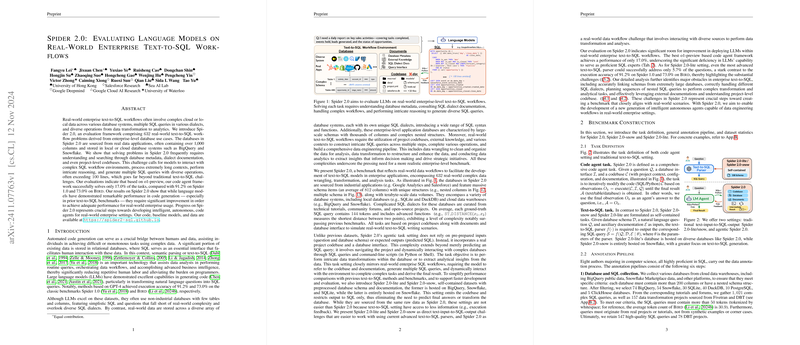Evaluating LLMs on Complex Text-to-SQL Enterprise Workflows: An Analysis of Spider 2.0
The paper "Spider 2.0: Evaluating LLMs on Real-World Enterprise Text-to-SQL Workflows" presents an evolved and intricate benchmark framework designed for assessing the capabilities of LLMs (LMs) in generating SQL queries from natural language inputs. The Spider 2.0 dataset introduces significant complexities beyond traditional text-to-SQL challenges, involving real-world, enterprise-level data intricacies. This newly developed benchmark reflects the demanding workflows faced in practical database environments like Google BigQuery and Snowflake, thus driving forward the evaluation and advancement of SQL generation models.
Key Contributions and Results
The Spider 2.0 benchmark contains 632 real-world text-to-SQL workflow tasks, drawn from genuine enterprise database use cases. The expansive schemas possess an average of over 800 columns, emphasizing the vast complexity that enterprise databases possess. Unlike earlier benchmarks such as Spider 1.0, real-world databases introduce numerous SQL dialects and obtuse functions that models must contend with, such as ST_DISTANCE for geographic computations.
The paper underlines the challenging nature of Spider 2.0 through its evaluation performances. The best-performing code agent framework based on OpenAI's o1-preview succeeds in solving only 17% of the tasks within Spider 2.0, a stark comparison to the 91.2% success rate observed on classic benchmarks like Spider 1.0. This highlights the substantial room for improvement among LLMs when tasked with handling intricate query requirements representative of enterprise environments.
The Spider 2.0 framework also reveals the striking deficiency in LLMs' abilities to navigate complex tasks such as schema linking, dialect-specific SQL generation, and integrating external knowledge resources. Existing frameworks like CodeR and Reflexion demonstrated limited success rates of 7.91% and 7.28%, respectively, underscoring the challenge posed by Spider 2.0.
Theoretical and Practical Implications
The implications from this research suggest a pressing need for developing more intelligent, contextually aware agents capable of understanding and interacting with complex enterprise databases. The benchmark sets a high standard for future work in automated SQL generation, aiming to bridge the gap between academic models and real-world enterprise needs.
Practically, successful improvements in this area can revolutionize how data engineers interact with complex datasets, easing the burden of manual query generation and enabling more efficient data processing capabilities. The benchmark, being highly reflective of actual database environments, sets a realistic stage for models that aspire to deploy reliably in business intelligence and data analysis tasks within industry settings.
Future Developments in AI
The path forward involves not only enhancing LLMs' comprehension of diverse SQL dialects but also their ability to perform dynamic reasoning within multilingual and multi-format environments. Future work should target the integration of adaptive learning strategies, enabling models to synthesize external documentation, understand project-level contexts, and execute comprehensive data engineering pipelines. Moreover, refining interaction with codebases to decipher task subtleties and execute multi-step transformations will be crucial.
In conclusion, Spider 2.0 sets a complex and fair challenge for evaluating and improving LLMs in handling real-world, multi-faceted database tasks, steering the future developments of AI towards being robust, adaptive, and contextually intelligent agents within enterprise settings. The research adds a significant layer of complexity and sets a new benchmark for the research community aimed at creating sophisticated, real-world applicable text-to-SQL models.
